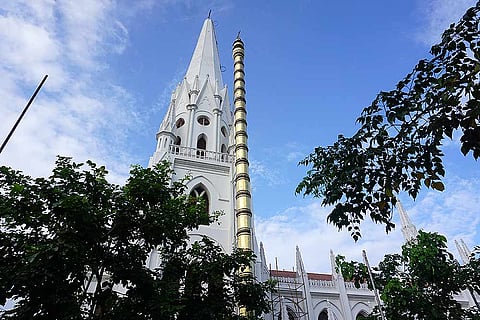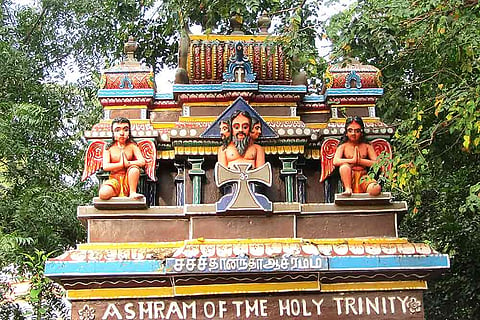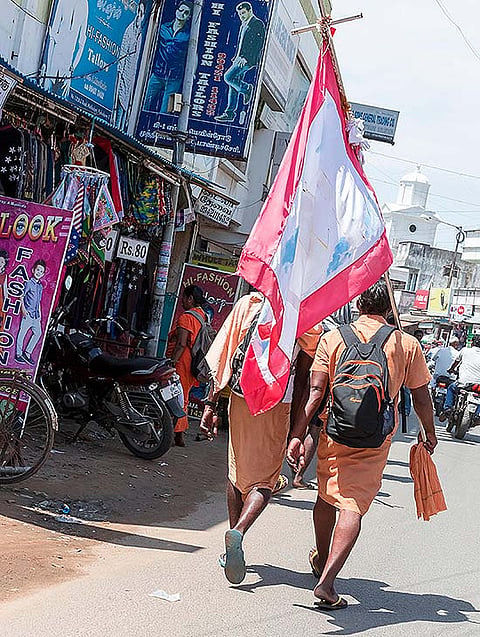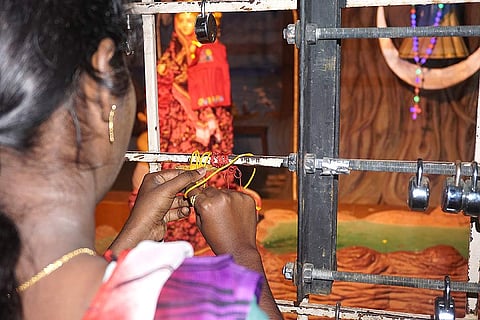Till a loudmouth of the saffron party in Tamil Nadu played it up, a majority in the state didn’t even think about whether their cine hero had a first name. He is Joseph Vijay, specified BJP’s H. Raja about the 43-year-old star, who had rarely proclaimed his Christian identity in public or through his movies. Only his letterhead reveals the full name. In film after film, Vijay has actually looked very comfortable playing the devout god-fearing Hindu villager, including in his latest Mersal.
A Rosary Of Rudraksha Beads
There exists a blur in the Tamil Christian identity. That is to smoothen proselytisation, argue critics.
Like Vijay, thousands of Christians in Tamil Nadu, particularly the Catholics, have no compunction in being associated with Hindu religious practices. Many incorporate them into their own worship of Jesus or Mary. Take, for instance, Sunitha. The young Chennaiite nervously tied the taali (yellow ‘mangalsutra’) around the white grill in front of the statue of Mother Mary in her city’s Velankanni church in Besantnagar. Her fists clasped in a tight grip and eyes closed, she prayed intensely for a couple of minutes before doing the cross sign even as her boyfriend looked on.
“We have been wanting to marry for two years, but there is opposition from both sides even though both of us are Catholics,” Sunitha says. It was then that a close relative suggested tying the taali before Annai Maria could fulfil her wish. Just as she and her friend walked into the church, another couple brought a small toy cradle, bought from the shop at the church entrance, and tied it to the same white grill. Their prayer: to have a child.

New flag mast at the vintage Santhome church
The taali and the cradle have been integral to many Hindu temples across the state, but their spread to the church represents a continuing ‘Tamilisation’ of Christianity. The flag mast in front of churches is another example. The metal-clad pole is modelled on the dwajasthambam—or ‘kodimaram’—in Hindu temples of Tamil Nadu and Kerala. However, it is the cross at their base in churches, unlike in temples where it is either a bull (for Shiva temples) or garuda (Vishnu temples). “They may look out of place in front of the tall spires, but even these masts have become a place of worship in the church,” says Chennai historian Vincent D’Souza. “With many donors keen to erect these masts, even centuries-old churches (in Chennai) like Santhome or Luz have willingly given space for them.”
The kodimarams at temples have to adhere to the shastras: the masts with specified height and circumference have to be placed between the main tower and the courtyard leading to the sanctum sanctorum. At the church, they are mostly concrete pillars covered by brass or five-metal panchaloha alloy—and erected right in the front. Not all nationalist outfits are amused. “It is a crass attempt to give a Hindu identity to a Christian place of worship,” argues Pa Senthil of the Hindu Makkal Katchi. “It’s only during festival days when churches used to have a flag mast, that too just temporary and wooden. Making it a permanent fixture is aimed at wooing gullible Hindus.”

Santhivanam Christian ashram near Trichy
Christian leaders disagree. For them, indigenisation is the word for such practices. The flag mast is only the “latest chapter” in such a “conscious move by our Church,” says Fr Jagath Gaspar, a Catholic priest who founded Tamil Maiyam, a cultural outfit that promotes Tamil Nadu’s native folk arts. “Christianity in Tamil Nadu has deliberately incorporated local practices associated with the Hindu tradition.”
Instances? Welcoming VIPs with the auspicious ‘poorna kumbam’ (a water-filled metal pot decorated with mango leaves and a coconut on top), draping the idol (Velankanni) in sarees, pulling chariots during festivals and carrying statues or pictures of saints in palanquins. “They are so evolved that even ‘anga pradakshinam’ (where a devotee rolls on the ground as a form of prayer in Hindu temples) is now performed by Christians as ‘kumbidu saranam’ in some churches,” points out Gaspar.

Christian pilgrims in Pondicherry
Other Christian rituals of worship also run closely parallel to Hindu formats. The annual Velankanni festival (near Nagapattinam, 350 km south of Chennai) is marked by devotees following a strict diet for set days, wearing light-saffron clothes and beads, making long walks to the church and even tonsuring the heads—all these resemble the temple pilgrimage Hindus undertake to Sabarimala, Tirumala or the Samayapuram Amman temple.
“None of these has been prescribed by the church or any Christian leader,” says Fr. Joe Vargese of the Besantnagar Velankanni church. “This has emanated from the popular devotion of the faithful. True, they may resemble Hindu practices but the Church cannot instruct the devout to eschew them. If they want to marry the local customs to the Christian faith, the Church cannot be a hindrance.” It is the same intermarriage of faith that brings thousands of Hindus to the Velankanni’s main shrine in the hope of a solution to their problems, he adds.

Famous Velankanni church
Christian missionaries have believed that such co-option of local practices, along with subaltern language in the Bible and prayers, has helped the Church integrate the new arrivals into the laity who otherwise could be vulnerable to returning to the mainstream. Veeramamunivar (Constanzo Besci), an 18th-century Jesuit priest from Italy who was also a Tamil scholar, was the first who attempted this ‘inculturation’, says theologian S. Emmanuel. “That was when he called Our Lady of Assumption at the Kamanayakkanpatti church (in south Tamil Nadu) ‘Periyanayaki’, a consort of Lord Shiva,” he recalls. “Such cultural inclusiveness was further endorsed by the second Vatican council in 1962-65 that urged local churches to encourage ‘inculturation’ in every possible way,” adds Dr Emmanuel.
Even Hindu festivals like Deepavali, Pongal and Ayudha Pooja are celebrated by many Christians these days, observes Dr Emmanuel, who heads PILLAR, a training centre in Madurai. “During Ayudha Pooja when Hindus perform poojas to their vehicles, Christians get their priests to bless their cars. A lot also has to do with children compelling their parents to adopt these practices,” he says. “On Pongal Day, Christian mothers can be seen making the festival sweet dish and even chorusing ‘Pongallo, Pongal’. Such multiculturalism has helped democratise Christianity here.”

In front of a Mother Mary idol in Chennai, a devotee ties a taali
The cultural crosscurrent has also seen Christians readily adopting art forms normally associated with Hinduism: Carnatic music and Bharatanatyam. Alexander Babu, a software engineer-turned-stand-up comedian is also an avid Carnatic music singer and yoga teacher—the last two are rare traits for a Christian. “My Carnatic guru (late) Suguna Puroshothaman had no hesitation in teaching me classical music once she recognised my singing talent,” he explains. “Resistance, if any, I faced only from fellow Christians who were not very comfortable with my singing Carnatic kritis that are in praise of Hindu gods. Left to me, I found my Carnatic singing only took me closer to divinity...even when I practised at home.”
Babu recalls fondly how his guru, days before her death in early 2015, had made him sing Yesu Kaaviyam, a rendition on Jesus, during a lecture-demonstration.
A lot of Christian gospels are currently sung to Carnatic ragas and metres, points out D’Souza, who also edits kutcheribuzz.com, a website on south Indian classical music. Christian TV channels like Nambikkai and Aaseervatham show Christian singers clad in ostentatious Kanjeevaram silk lip-syncing to Carnatic-based gospels in praise of Jesus. Middle-aged Sister Hema John, a Brahmin Carnatic singer who converted to Christianity when she was 24, is virtually a superstar among Christians for her effortless and appealing rendition of Carnatic-based gospel in Tamil.
Fr Paul Poovathingal, a Kerala priest who sings Carnatic-based prayers during the Holy Mass, attests that Indian Christians on listening to them actually scaled new heights of devotion since their ears were more attuned to Indian music. “I tell my devotees and the clergy in my state that Carnatic ragas and talas are soaked in devotion compared to choir music. Slowly they have started accepting these raga-based songs in the church.” Poovathingal, a trained classical musician with a PhD in ‘Carnatic music and Christianity’, recalls that the Tamil language too had a rich tradition of Carnatic and folk-based Christian music that was replaced by Western choir music during British rule. A 56-year-old vocologist from the state’s cultural capital Thrissur, he is confident that the Indian music being heard in Kerala’s churches will soon spread to Tamil Nadu as well.
Compared to the similarity of religious practices, the cultural connection is slow but happening: festivals organised under the aegis of churches are now incomplete without a Bharatanatyam performance. The communication explosion also helps in opening up cultural bottlenecks, feels D’Souza. “The local language, metre and themes are easier ways of expression compared to an imported style of singing and dancing,” he says. “Ultimately,” adds Dr Emannuel, “what wins out is the greater comfort level in being a Tamil or Indian Christian than mimicking a European Christian.”
By G.C. Shekhar in Chennai
Tags